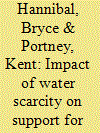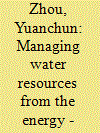|
|
|
Sort Order |
|
|
|
Items / Page
|
|
|
|
|
|
|
| Srl | Item |
| 1 |
ID:
175251


|
|
|
|
|
| Summary/Abstract |
The rise of unconventional oil and gas development in the form of hydraulic fracturing, or fracking, has drawn much attention from media, scholars, and policy makers, and Texas has frequently been the epicenter of this attention. This paper looks at fracking through a particular lens, that of an extraction process that relies heavily on water. This “water-energy nexus” has been studied in terms of the physical connections, but little research exists on how ordinary people might understand that nexus. This paper examines the effect of people's awareness of the water-energy nexus and county-level drought characteristics on their support for increased regulation of water issues associated with hydraulic fracturing. The analysis uses data from a Texas-based public opinion survey, and county-level data from the U.S. Drought Monitor and the Texas Railroad Commission. Multi-level modeling techniques are used to examine the impact of proximity, local water scarcity, and individual awareness of the water-energy nexus on people's willingness to support regulating aspects of water in hydraulic fracturing practices. The paper supports the hypothesis that individual awareness of the energy-water nexus and local water scarcity affects willingness to support greater regulation and concludes with some policy recommendations to improve policy transparency surrounding hydraulic fracturing.
|
|
|
|
|
|
|
|
|
|
|
|
|
|
|
|
| 2 |
ID:
163555


|
|
|
|
|
| Summary/Abstract |
As one of the most developed provinces in China, Jiangsu province is facing both energy and water stresses. The impact of energy production on water resource remains to be seen, especially in terms of a changing climate. In this study, we adopt a Long-range Energy Alternatives Planning System (LEAP) model combined with plant-level data to study the impact of energy policies on water resources management. The results indicate that energy efficiency improvements and industry structure optimization can result in 40% and 33% water withdrawal savings respectively in the future depending on the level of optimization. With several integrated measures, total water use can meet the 2030 targets set by the Jiangsu provincial government. Shifts in cooling technology can bring significant water-savings benefits and help fulfill water use-control targets. Furthermore, we find that the Suzhou and Xuzhou administrative areas will experience power output efficiency reductions and will need more water in 2030 under the RCP45 and RCP85 scenarios. More efforts are needed to mitigate climate change and offset its negative impact on energy and water resource. The results of this study will be informative for both resource management and policy design.
|
|
|
|
|
|
|
|
|
|
|
|
|
|
|
|
| 3 |
ID:
162966


|
|
|
|
|
| Summary/Abstract |
China's water and energy sectors are both facing challenges induced by uneven distribution of supply and demand. On top of that, the two sectors are intertwined together, further exaggerating the country's water and energy stresses. This study conducts a quantitative analysis to estimate water for energy and energy for water at the provincial level in China using a bottom-up approach. It also examines the provincial interdependence of resource from a nexus perspective. The results show strong geographical variances. In 2014, the water for energy ranged from the highest of 3483 million m3 in Sichuan to the lowest of 72 million m3 in Hainan. Concerning the energy for water, Jiangsu had the largest with 12.6 TWh, while Tibet ranked the lowest with only 8 TWh. Moreover, the inter-provincial water and energy transfer is causing a vicious cycle of resource over-exploitation. It is urgent to integrate the water and energy management during policymaking and regional planning. Efforts should also be made to improve the provincial self-sufficiency through demand-side conservation and supply diversification.
|
|
|
|
|
|
|
|
|
|
|
|
|
|
|
|
| 4 |
ID:
167005


|
|
|
|
|
| Summary/Abstract |
As the world's largest proposed infrastructure program, China's Belt and Road Initiative will have significant implications for water security, sustainability, and the future of energy generation in Asia. Pakistan, a keystone of the Belt and Road Initiative, presents an ideal case for assessing the impacts of the Initiative's energy financing. We estimate the future water demands of seven new Chinese-financed, coal-fired power plants in Pakistan with a total capacity of 6600 MW. While these facilities may help address Pakistan's energy shortages, our results indicate that by 2055, climate change-induced water stress in Pakistan will increase by 36–92% compared to current levels, and the power plants' new water demands will amount to ∼79.68 million m3. Our findings highlight the need for China and the Belt and Road Initiative's destination countries to integrate resilience and sustainability efforts into energy infrastructure planning. Policy recommendations are offered to permit both sustainable development and responsible water resource management.
|
|
|
|
|
|
|
|
|
|
|
|
|
|
|
|
|
|
|
|
|